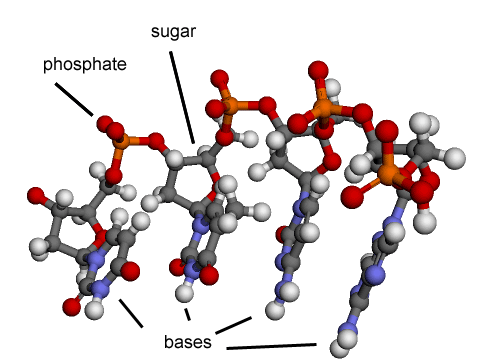|
History of the Universe eBook. 398 pages, 300 illustrations only £5.99
Nucleic AcidWe have just seen that to build a protein, life needs to know which amino acids to join together and in what order. The instructions on how to do this are stored in the other type of molecule essential for life: the nucleic acids. Nucleic Acid BasesNucleic acid is constructed from simpler molecules called bases. Life mostly uses four different types of base: thymine, cytosine, guanine and adenine (sometimes shortened to TCGA).
The main four bases used by life In the diagram we show two different views of each of these bases. Notice how flat they are! This allows them to stack up side by side like a pack of cards. Notice also that hydrogen and oxygen atoms are scattered around the outside of these molecules. These atoms can make hydrogen bonds with other molecules, such as water. On the other hand their large flat faces were mostly slippery, unable to form hydrogen bonds. Finally notice that two of the bases are larger than the other two. Nucleic Acid ChainsThe result was that, when they fell into water early in the history of the Earth, these bases tended to stack up, with their flat faces touching, like a stack of plates. If this water also contained sugars and other groups called phosphates then perhaps it was relatively easy for them to be dry-joined together to make the molecules we now call nucleic acids.
Nucleic acid molecule Each base was attached to a sugar molecule, and the sugars were joined together by phosphate molecules to form a long chain. As well as easily stacking together, these bases also had another property which life was to find invaluable.
History of the Universe eBook. 398 pages, 300 illustrations only £5.99 |
eBook only £5.99 398 pages, 300 images  "I find the science fabulous...an extremely useful teaching tool." Professor David Christian. Follow @WykenSeagrave |

The complete history of the Universe -- from the Big Bang to 200 my into the future

